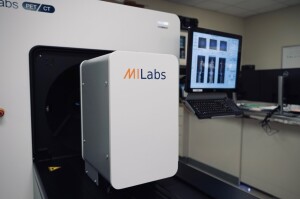by
John R. Fischer, Senior Reporter | February 09, 2024

The researchers will develop dual MR-PET imaging agents to identify amyloid plaques for diagnosing Alzheimer's in living patients.
A $3 million grant from the U.S. National Institute on Aging has set in motion a multi-departmental project over the next five years in the Biomedical Imaging Center at the Beckman Institute for Advanced Science and Technology where researchers from different disciplines will develop PET and MR imaging agents for early detection of Alzheimer’s disease.
The grant will be divided among scientists in Beckman’s Magnetic Resonance Imaging Laboratory and Molecular Imaging Laboratory, both of which are part of the center. Imaging experts, in vivo brain neurology specialists, and researchers specializing in synthetic inorganic molecules in vitro will develop solutions that overcome the challenges associated with amyloid aggregates, a hallmark of the memory-loss disease, including:
- MR agents that target amyloid plaques. Currently, none exist.
- PET imaging agents for small-scale aggregates. The few FDA-approved ones are unable to detect small-sized plaques, and in some cases produce false-positive test results when diagnosing Alzheimer’s.



Ad Statistics
Times Displayed: 46592
Times Visited: 1410 MIT labs, experts in Multi-Vendor component level repair of: MRI Coils, RF amplifiers, Gradient Amplifiers Contrast Media Injectors. System repairs, sub-assembly repairs, component level repairs, refurbish/calibrate. info@mitlabsusa.com/+1 (305) 470-8013
- Imaging agents and drug therapies that can pass through the blood-brain barrier. The superimpermeable system of blood vessels and capillaries prevents these solutions, which are made up of molecules and antibodies, from reaching the brain to diagnose and treat neurodegenerative diseases.
“I’m looking forward to high-resolution imaging of the brain and its structures,” said Wawryzneic Dobrucki, the Neil and Carol Ruzic scholar for biomedical and translational sciences and an imaging expert specializing in PET scanning, in a statement.
Currently, identifying amyloid aggregates to accurately diagnose Alzheimer’s can only be done post-mortem. The collaboration seeks to create tools that can identify soluble beta-amyloid peptide aggregates and larger insoluble amyloid plaques in living patients.
The work has already begun with the development of customized molecules capable of crossing the blood-brain barrier to detect amyloid. Additionally, a copper-based PET imaging agent has been tested in preclinical trials and successfully facilitated imaging on transgenic Alzheimer’s in mice. The team will refine it to be able to pass through the human blood-brain barrier and image multiple markers of the disease and other neurodegenerative conditions at earlier stages.
The researchers will work to make the imaging agents dual-purpose, capable of being used with both PET and MR scanners. They will perform in vivo MR studies to evaluate the performance of these dual-modality diagnostic agents for Alzheimer’s and other forms of dementia.
Back to HCB News

